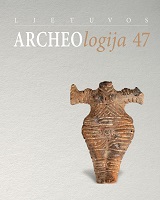DONKALNIO IR SPIGINO KAPINYNŲ AKMENS AMŽIAUS ŽMONIŲ KILMĖ IR MOBILUMAS STRONCIO IZOTOPŲ ANALIZĖS DUOMENIMIS
THE ORIGINS AND MOBILITY PATTERNS OF STONE AGE HUMANS FROM THE DONKALNIS AND SPIGINAS BURIAL GROUNDS ACCORDING TO STRONTIUM ISOTOPE ANALYSIS
Author(s): Gytis Piličiauskas, Edvardas Simčenka, Justina Kozakaitė, Žydrūnė Miliauskienė, Giedrė Piličiauskienė, Harry Kenneth RobsonSubject(s): Archaeology, Regional Geography, Migration Studies
Published by: Lietuvos istorijos institutas
Keywords: Strontium isotope analysis; migration; mobility; Stone Age; Lake Biržulis;
Summary/Abstract: Whilst the analysis of strontium isotope ratios (87Sr/86Sr) of human remains enables mobility patterns and migration events to be identified archaeologically, its potential is dependent on the heterogeneity of the underlying geology in the research area, and the knowledge of 87Sr/86Sr ratio variation in the biologically available strontium. In Lithuanian archaeology, strontium isotope analysis has only been relatively recently undertaken (2019–2020). In this paper we discuss the potential of the method, and its application to materials from the Stone Age burial grounds of Donkalnis and Spiginas located on former islands in the Lake Biržulis region, western Lithuania.
Journal: Lietuvos archeologija
- Issue Year: 2021
- Issue No: 47
- Page Range: 209-233
- Page Count: 25
- Language: Lithuanian

